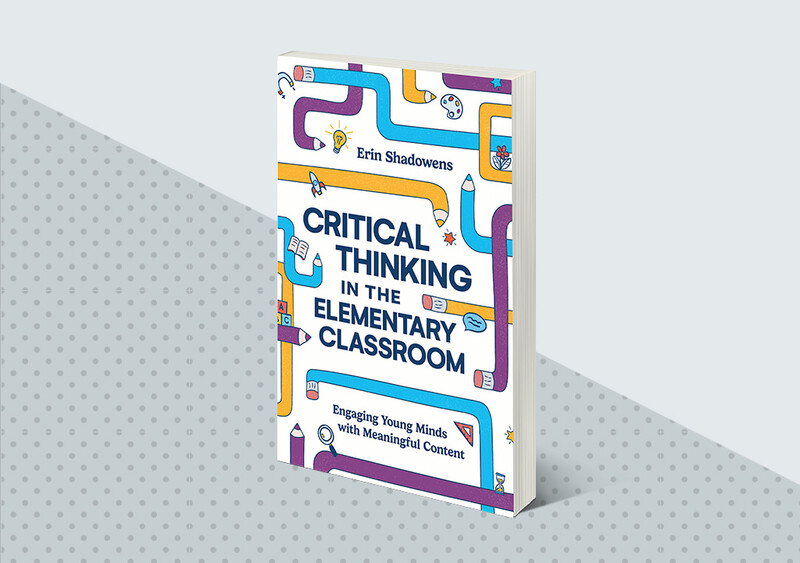“Schools need to stop rote learning. What schools really need to teach is critical thinking!” Have you heard that one before? How about this one: “People don’t know how to critically think because independent thought is not valued!”
Critical thinking. It’s a term used often but rarely defined. What precisely does anyone mean when they call something “critical thinking”?
In my book, Critical Thinking in the Elementary Classroom (ASCD 2023), I define critical thinking as analysis and evaluation to form a judgment. In other words, we analyze and evaluate information to make decisions about all kinds of things from the academic to the personal. But we can’t sit students down and definitively say, “This is analysis” and “This is evaluation” and “This is formulating a good opinion.” The process of analyzing, evaluating, and judging information is context-dependent. If we want our students to be critical thinkers, they need to know a lot about a lot. Their curriculum, starting at an early age, needs to broaden and deepen their knowledge. If we want our students to be critical thinkers, they need to know a lot about a lot.
This description of critical thinking may seem dull compared to the typical images conjured of critical thinking in action–images of great debates about hard, divisive questions; collaborative projects where students take on a relevant issue in their community. Unfortunately, classrooms that throw students into debates and projects where they lack enough information about a topic to make cogent contributions simply re-enact the same sorry state of affairs displayed daily on 24-hour news channels: people blowing a whole lot of hot air with little to back it up.
“Okay,” a critic might say, “so you’re proposing that we just do what we’ve always done. We make kids memorize a bunch of boring information and hope they learn how to critically think about it all!”
I offer three responses to this criticism:
Kids don’t memorize much anymore. Factual knowledge that used to be standard in an elementary curriculum, such as in the subjects of science and social studies, has been eliminated in many schools. For instance, when I was in 4th and 5th grade, I was expected to know the names of all the states and capitals in the USA. Few elementary schools remain with those kinds of requirements. (I recommend the work of journalist Natalie Wexler, who has documented this phenomenon, and the Knowledge Matters Campaign, which promotes knowledge-building literacy curricula in schools.) The impact of students having less factual knowledge is they are less able to understand and think about a topic, which can especially undermine their reading comprehension. Kids should learn facts in school, and that will require them to do some memorization; nevertheless, the implication is not to force kids to blindly memorize disconnected facts, but to acquire factual knowledge in a way that asks them to actively process their learning. Knowing things is not boring. In fact, the more knowledge we possess, the easier it is to think about a topic. When kids have the necessary prerequisite skills and knowledge, they are better equipped to enjoy activities that push their thinking.
Critical thinking emerges from deepening factual knowledge and understanding about a topic; however, it does not emerge by accident. Educators can utilize instructional tools, such as my Critical Thinking Framework, to extend and enrich student thinking.
The Critical Thinking Framework found in my book outlines five instructional approaches teachers across all grade levels and subjects can incorporate into their practice. It is designed to be integrated with content to get students talking and thinking. Teachers can apply the framework to their current curriculum so students more deeply process the content they are learning.
When kids have the necessary prerequisite skills and knowledge, they are better equipped to enjoy activities that push their thinking.
The Critical Thinking Framework
1. Say It In Your Own Words: Students articulate ideas in their own words. They use unique phrasing and do not parrot the explanations of others. Students who can construct explanations in their own words better understand the material.
Fourth graders are learning about electric circuits. They have learned about conductors and insulators to build their own circuits. At the start of class, they jot down their own definitions of the key vocabulary using their own words. One student, Javier, shares their definition of a conductor: “The conductor completes the electric circuit.” The teacher volleys back to the class. “Javier just shared his definition. Dana, what does that mean in your own words?” Dana replies, “That means the conductor lets electricity flow through it.”
2. Break it Down: Students break down the components, steps, or smaller ideas within a bigger idea or procedure. When students understand the parts of an idea, they are better able to apply their understanding to new situations.
In a 2nd grade math lesson, students are reviewing how to regroup a bundle of tens when adding two digit numbers. The class is looking at a student solution to the problem 45 + 27. The teacher highlights the ones place in the problem. “The student wrote 2 in the ones place and added a 10 to the tens place, but I know 5 + 7 equals 12. Why did they do that?” After a turn and talk, one second grader shares, “12 is the same as 10 + 2. The student separated the 10 and 2 and added the 10 to the tens place and kept the 2 in the ones place. They did this so they can add all the tens together.”
3. Look for structure: Students look beyond shallow surface characteristics to see deep structures and underlying principles. This allows students to recognize and tackle other tasks with similar structures.
Continuing the above scenario, the teacher then asks the students, “What big idea can we remember for adding two digit numbers?” After a discussion, the students decide on the following big idea: “Any time we are adding 10 or more ones, we can break apart the number into tens and ones to make it easier to add.”
4. Notice gaps or inconsistencies in ideas: Students ask questions about gaps and inconsistencies in materials, arguments, and their own thinking. This process helps students monitor their own thinking.
Third graders read and discuss the text, “Thank you, Mr. Falker.” After reviewing student writing about the text, their teacher presents one anonymous short response that represents a trend in the classwork. The teacher asks, “What do you notice this student did well? Where is there room for improvement?” The class notices that the student provides a strong description of the story’s central message, but the examples given do not support the claim. The teacher follows up, “What question can we ask ourselves to make sure we’re selecting strong evidence?” One student responds, “We have to ask ourselves: Did I prove myself?” The class then revises and strengthens the response.
5. Reason with evidence: Students construct arguments with evidence. Students also evaluate the evidence in the reasoning of others. When students are accustomed to reviewing and weighing evidence, they slow down and carefully consider an argument before drawing a conclusion.
In a kindergarten lesson on weather, students go outside to make observations. After sketching the clouds they see, the students discuss and label the type of cloud. Most students agree the sky is full of “cumulus” clouds. The teacher prompts students to prove it with evidence. They respond, “The clouds are fluffy and white.” The teacher then tells the students that the weather report for tomorrow predicts rain. “What types of clouds will we expect to see then?” The class reviews an informational text describing cloud types and weather patterns. Students raise their hands to put their finger on the image or sentence that shows a “cumulonimbus” cloud.
Unlocking Student Potential
When reading through these examples, some educators may be taken aback by the vocabulary and phrasing the students use; it may even be tempting to disregard the examples, especially ones involving the youngest students, as beyond what they are capable of. However, all the examples are based on real classrooms. The framework provides a lens through which educators can extend and deepen student thinking by asking them to analyze, evaluate, and form well-reasoned judgments. Lessons that pair knowledge-building with opportunities to actively process and make meaning can powerfully impact student learning. In doing so, we will expand our definition of what’s possible in the classroom. It’s what the children we serve deserve. When we expect more from our students, and provide them the support they need, they will wow us with the depth and breadth of their minds.
Critical Thinking in the Elementary Classroom
Even young students can develop vital critical thinking skills when they have access to rich content, meaningful opportunities to practice, and guided instruction.









